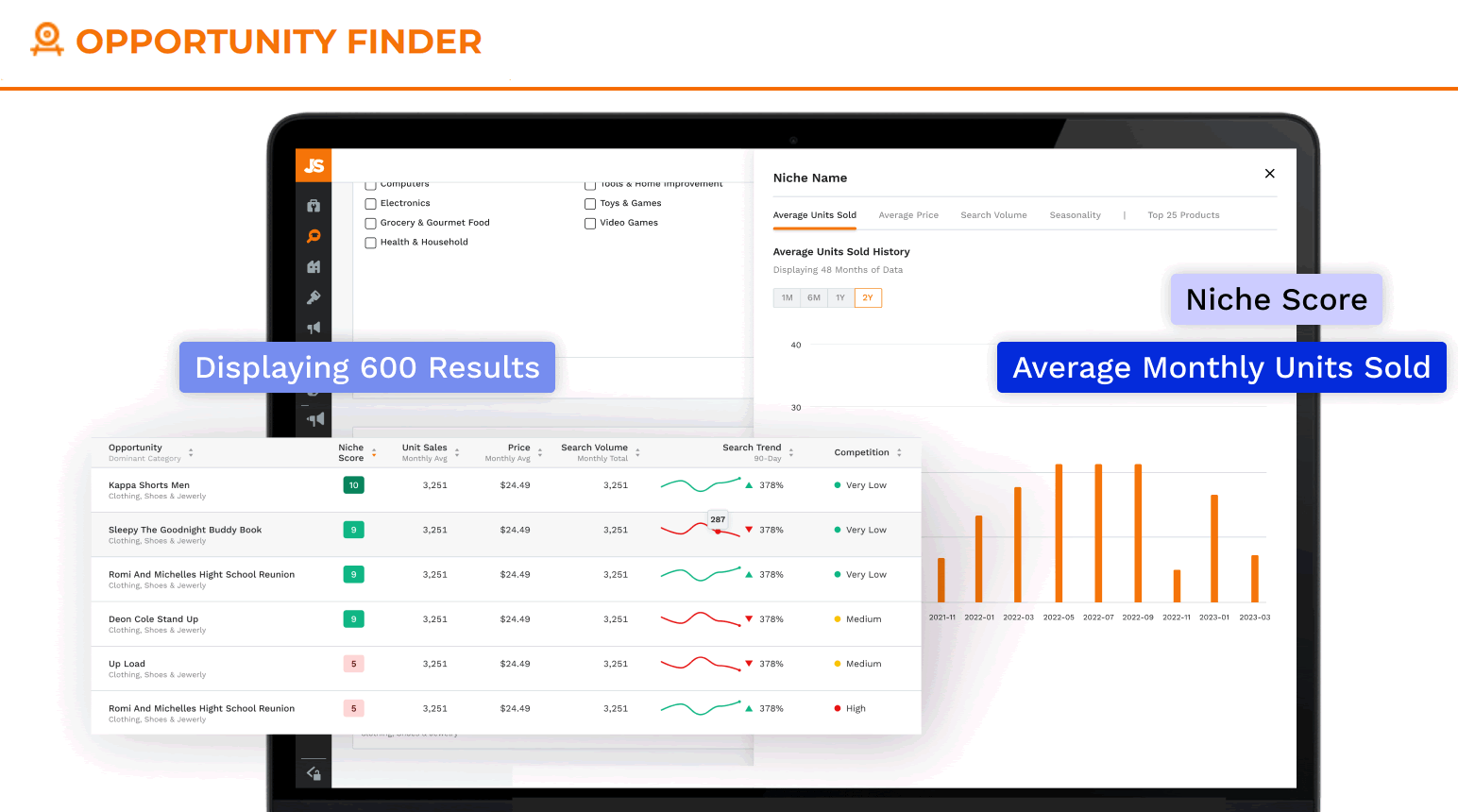Opportunity Score Jungle Scout
Inicialmente, el Jungle Scout Opportunity Score fue una forma rápida de evaluar posibles nichos en Amazon bajo la Jungle Scout Opportunity Finder . Sin embargo, el entorno de comercio electrónico está cambiando a diario, por lo que lo que funcionó ayer puede no ser cierto hoy. Opportunity Score tradicional ha perdido su confiabilidad debido a su naturaleza estática e su incapacidad para adaptarse a los cambios de mercado en tiempo real . Entonces, lamentablemente, ya no está disponible como una métrica en la Opportunity Finder .
Como experto en ventas en línea, puedo dar fe de que el éxito requiere un enfoque dinámico. No estoy hablando de lo que funcionó hace 5 años, sino hace 5 meses. Hombre, es una locura.
No puedes confiar únicamente en una partitura singular ; En cambio, el análisis exhaustivo de mercado y el monitoreo de tendencias son cruciales. Al comprender los UPS y Donws del mercado de Amazon, puede tomar decisiones informadas que se alineen con el clima económico actual.
Además, el puntaje a menudo pasa por alto factores como la presencia de marca y la lealtad del cliente , lo que puede afectar significativamente el rendimiento de un producto en Amazon. Es esencial mirar más allá de los números y considerar la visión holística del mercado.
Entonces, ¿en qué puntaje debo confiar? La respuesta es Accusales y, también, la puntuación de nicho .
Consejo profesional: Manténgase actualizado con Jungle Scout , ya que continuamente mejoran sus herramientas para alinearse con el mercado de Amazon en constante evolución.

¿Cuáles son las alternativas al Opportunity Score?
Si bien el Opportunity Score ya no funciona, puede usar varias alternativas que proporcionan una perspectiva más amplia sobre el potencial de mercado:
- Investigación manual: el análisis manual de datos puede descubrir matices que los puntajes automatizados pueden perderse. Use la base de datos del producto .
- Análisis competitivo: evaluar las fortalezas y debilidades de sus competidores puede ofrecer ideas estratégicas. Use el Sales Estimator .
- Comentarios de los clientes: las revisiones y calificaciones pueden revelar brechas en el mercado que representan oportunidades sin explotar. Use el descargador de revisión y la AI assist .
Estos métodos, combinados con análisis avanzados de herramientas como Opportunity Finderde Jungle Scout, pueden brindarle una comprensión más en uno de su éxito potencial en Amazon.
¿Qué tan preciso fue el Opportunity Score Jungle Scout vs Accusales?
Si bien la Opportunity Score Jungle Scout ofreció una instantánea de potencial, su precisión no es infalible. Se basa en algoritmos que estiman la demanda y la competencia, por lo que debe corroborarse con los últimos datos del mercado y tendencias para la confiabilidad.
Para las ideas más precisas y procesables, combinó la Opportunity Score con otros métodos de investigación, como el uso del Jungle Scout Extensión de Chrome y análisis de tendencias del mercado.
¿Cómo se calculó el Opportunity Score ?
El Opportunity Score se generó a través de un algoritmo patentado teniendo en cuenta la demanda, la competencia y la rentabilidad . Sin embargo, a medida que evolucionó el entorno de comercio electrónico, el análisis en tiempo real sustituyó la métrica.
Consejo profesional: combine múltiples herramientas Jungle Scout Opportunity Finder y su puntaje de nicho, para obtener una visión holística del mercado y tomar decisiones basadas en datos.
¿Qué significa el puntaje de nicho en Jungle Scout?
Aha, otra métrica desactivada. Una de mis herramientas favoritas fue el nicho cazador (DEP) y la puntuación de nicho fue su métrica central. En Jungle Scout , el puntaje de nicho representaba (y todavía lo hace) el largo potencial de una historia corta de un segmento de mercado específico . Evaluó factores como la demanda del cliente, el nivel de competencia y el potencial de ingresos, ofreciendo orientación para la selección informada de nicho para productos de Amazon FBA. 3 colores: rojo, amarillo y verde, representaba la viabilidad de un cierto nicho y, también, una puntuación de 0 a 10.
Long vive el rey
En pocas palabras, tanto Opportunity Score como el cazador de nicho, donde se desaproban y sustituyeron por datos en tiempo real como Accusales y The Niche Score bajo la herramienta Opportunity Finder . A medida que el entorno de comercio electrónico, las herramientas de Jungle Scout también evolucionan (¡a veces demasiado rápido!) Y también deberían sus estrategias.